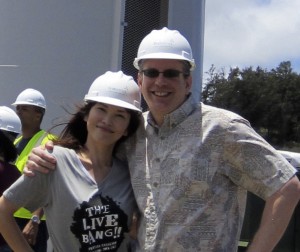
Thomas Pals with his wife Miki and some of his students at a wind farm in Hawaii
Read the Introduction, where you’ll also find links to previous posts in this series.
Originally from the Twin Cities of Minneapolis and Saint Paul, THOMAS PALS has lived and worked in Japan for over 20 years. His current position as an adjunct English Professor in the Department of Science and Engineering at Ritsumeikan University allows Tom to design and teach courses including academic writing, science in civilization, technology and business, and engineering for developing countries. Tom has co-authored a number of English language texts for science and engineering students. He has lectured and presented throughout Asia and even occasionally in North America.
Unlike his good friend Allyson, Tom laments the fact that his job includes writing. This post could well be his one and only attempt at writing something non-academic. In his free time, Tom likes to BBQ, brew various IPAs, hike, and travel. He lives with his wife Miki near Kyoto, Japan.
* * *
These are my seven treasures:
1.
Saturday, February 7th, 1970, was a beautifully warm winter’s day. Even though I was only seven and a half years old, I remember it — the day my grandfather died. Some kids had broken into a vending machine to steal candy. While trying to chase them down, my grandfather collapsed on the street in front of the small dry cleaning and coin laundry shop he and my grandmother owned. He died of a heart attack right there in his wife’s arms.
The next day my grandmother called me into their bedroom and handed me my grandfather’s wooden cane. “I want you to have this,” she said through her tears.
My grandfather hadn’t always needed his cane. He only used it on days when his knee was bothering him. Other days you would find me running down the hallway with it, ready to pole-vault over anything that tried to block my way. When my grandfather couldn’t find his cane, he always knew to ask me where it was.
It’s hanging now on the inside knob of my bedroom door. When the time comes that I need it, I’ll know where it is.
2.
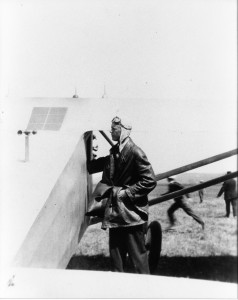
Charles Lindbergh
You can get a photo of Charles Lindbergh off the Internet in about two seconds. But how many can you say were taken by your grandmother the day she met him?
Bonnie June Carlson didn’t seem to think it was a big deal, but I have the proof: a black-and-white photo of Lucky Lindy standing next to the Spirit of St. Louis. How could she have met Charles Lindbergh and never mentioned it? Was it some sort of secret?
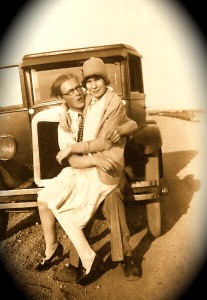 And there were other photos too. One of her playing baseball with her brothers. And another of her sitting on Grandpa’s knee on their very first date. She was 53 when I came into the world, and apparently she had already lived a full and amazing life. I knew her for less than half of it, yet in that time she astonished me. She gardened. She travelled. She read. She comforted. She laughed. It was hard to see her go, but at 100 she had lived a remarkable life. Having recently reached 50, I wonder if years from now my life will look even half as interesting to anyone.
And there were other photos too. One of her playing baseball with her brothers. And another of her sitting on Grandpa’s knee on their very first date. She was 53 when I came into the world, and apparently she had already lived a full and amazing life. I knew her for less than half of it, yet in that time she astonished me. She gardened. She travelled. She read. She comforted. She laughed. It was hard to see her go, but at 100 she had lived a remarkable life. Having recently reached 50, I wonder if years from now my life will look even half as interesting to anyone.
My grandmother’s photo of Lucky Lindy sits on my desk, reminding me to live amazingly now, and always.
3.
A good gas grill is hard to come by in Japan. People grill here, but not at home and not with gas. They bring a portable charcoal grill to the beach or riverside and have a picnic. That’s great, but not convenient. Another problem is that the charcoal is usually natural hard wood from a developing Southeast Asian country. Chopping down forests for the sake of some grilled food is just not a very good idea. That’s why I was thrilled when I found a genuine Coleman gas grill for sale at Costco in Fukuoka.
My yearly summertime visits to my brother’s Minnesota place always feel like home. Together we grill almost every night I’m there. Now, in Japan, my house is a summertime haven for Japanese friends, and co-workers who miss the North American cookout. It’s not all burgers and brats, though. Lots of veggies and sea creatures join in on the fun. Ever grilled fresh octopus? How about tofu, sweet potato, okra, or eggplant? I just add some homebrew from the kegerator and younger teachers think they know why I’m called Professor Pals.
4.
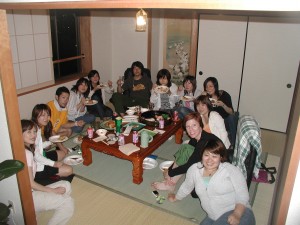 Here’s something else you may not know about living in Japan. For the most part there is no central heating. If it is cold outside, it is cold inside.
Here’s something else you may not know about living in Japan. For the most part there is no central heating. If it is cold outside, it is cold inside.
My wife and I always sit on the floor. The only furniture we have is a TV stand, a few flat cushions, and our kotatsu, which is the centre of our home as it is any traditional family home. It is our coffee and dinner table rolled into one. In the winter, you simply remove the top of the table, throw on a nice warm blanket, replace the top, and turn on the little space heater attached to the table’s underside. Instant warmth and comfort. If you get sleepy, you lean back on the tatami floor and take a nap.
I really can’t tell you how many times my family, friends, co-workers and students have congregated around my kotatsu. But the numerous photos of nabe, sukiyaki, and yakiniku parties stand as evidence of shared moments together. Would these gatherings be as numerous or memorable with a normal table and chairs? Somehow I doubt it.
There is magic in the design of this Japanese table, the tatami mat floor, and the family atmosphere these create. If and when I ever move back to North America, my kotatsu is coming with me.
5.
My parents split when I was just 4 years old. I don’t remember ever seeing my mom and dad love each other. I never saw them fight either. I was just too young. God bless my mom, who at age 34 was left to raise five of us on her own. As a kid, I never really knew the hardships because she was a steadfast, loving mother. As an adult, I finally understand what she went through.
The rejection we all felt as a family did affect us. It is part of who I am. So when a couple years ago I came across a photo of my mom and dad together, I was shocked. In it, my dad is sitting sideways with his legs casually draped over one arm of the chair as his head rests on the other. He has his right arm around her, pulling her in, and he’s looking up at her. She is facing the camera with a serene smile on her face. Of course we had taken some family photos before the breakup, but in this photo they looked so … in love. So natural together. My dad really must have cared for her at one point.
When I asked Mom why I had never seen it before, her eyes grew sad. She hadn’t consciously hid the photo. For years it was just too painful for her to look at. It is a photo of love soon to be lost, and heartache yet to come. I can feel my mom’s pain when I look at it, but at the same time, I am mesmerized.
Since I scanned it into my computer, I often find myself going back to it. I’ve even shown it to other family members, but I am not ready to share it with you. You may not see its true value, and that would be a shame.
6.
An iPad may seem like a lame choice for a treasure. I think so too. It’s not really the iPad itself that is a treasure, but what it can do — and with whom.
When I first moved to Japan over 20 years ago, it cost me $3 a minute to call home. How things have changed. Just this week, on my iPad, I talked to my high school buddy living in Thailand, my brother in Minnesota, a nephew coming to Japan for a visit, and a colleague here in Japan who needed some help with work. Total cost: $0. Not to mention the fact that — also on iPad — I ordered flowers for my mom for Mother’s Day, gave a lecture about genetics, watched a Twins game, finished reading Ben Franklin’s autobiography, and received a message via Facebook from a friend in Canada who asked me to write a guest post.
Sometimes technology rocks.
7.
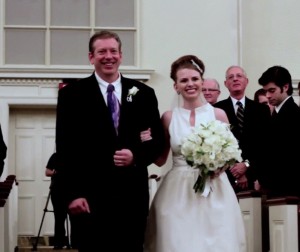
Tom walking his niece Samara down the aisle. "The tie almost looks purple here. It's not. It's blue. But then again, I'm not really that red either."
My nephew Schuyler gave me my favourite tie. Every time I wear it, someone comments on what a great tie it is. Normally I don’t wear one, but this tie makes me feel almost … fashionable.
It is a blue necktie designed by Jerry Garcia, but it comes from the Steve collection. That would be my brother Steve. My nephew swiped it right out of his closet — because I asked him to. Not this particular tie, but one that both he and his father both liked. Since my lawyer brother was kind of a clotheshorse, I knew I would get a good one.
The first time my brother Rick saw it, he asked me where I got the cool tie. I told him I got it from Schuyler via the Steve collection — and now Rick has one too. We like our ties because they are more than just great neckwear. You see, the Steve collection has only limited editions.
I miss my big brother. He demonstrated so much to me about life, and yes, death. This treasure that I got for free has a cost that is sometimes almost too much to bear. But on New Year’s Eve 2011, when I walked his daughter down the aisle, I was proud to wear my tie from the Steve collection.
Thomas, I read about your seven treasures and had tears in my eyes at the end. Then I read the blurb at the top about you and saw that this may be your first and last attempt at non-academic writing. What a shame that would be because you obviously have stories to tell. I wanted to hear more. Please rethink your position.
I couldn’t agree more, Mary. Tom’s a writer, whether he realizes it or not. I’m so glad you enjoyed his post. Thanks for commenting.
If Tom doesn’t continue to write in the non-academic realm, we readers will be the ones lamenting the loss of really compelling and interesting storytelling voice. I will be waiting for the memoir. I’m sure there is an editor, specializing in memoir, who would offer encouragement.
That’s funny, Christine. I said much the same to Tom — that I knew he must have many stories to tell, not only about his 20+ years in Japan, but about other aspects of his life. btw, despite what he says here, he didn’t put up too much resistance when I asked him to contribute his Seven Treasures. Then again, I can be quite persuasive, even over iPad. 😉
Ally – It didn’t matter that I was busy, or that I knew it would be hard, or even that I did not want you to find out that I can’t write. I said, “yes” because you asked.
Aw, Tom. What can I say …? Thank you.
And like others who’ve commented so positively, I sincerely hope this is not the last creative writing you do.
From Yuriko Adachi-Tanaka in Japan:
“Thank you for sharing your beautiful essay, Tom. I’ve known you over 20 years, but I feel like now I know where your loving personality comes from. By the way, you are living in a more Japanese way than I am, since I don’t have kotatsu in my house. :)”
Yuriko,
It’s so true that Seven Treasures posts tell the reader a great deal about the writer — not just through the treasures they choose, but also in the way they tell the stories. I too found out things I hadn’t known about Tom, though everything fit with the funny, outgoing, and sensitive person I know him to be.
P.S. I still miss my kotatsu even after all these years back in Canada!
Thank you all for the encouraging comments. But the truth is that Allyson made my stories come to life.
Have you ever heard of the Japanese art form of “dorodango”? Basically dorodango is the art of taking just plain old dirt and changing it into a beautiful shiny sphere. I gave Allyson some dirt, and she formed it into something better. The fact that anyone found meaning in it is still amazing to me.
If Ally ever has a writers’ retreat in the Kyoto area, you are officially invited to sit around my kotatsu. I am sure we will find something to eat, drink, and talk about.
Tom
wonderful wonderful wonderful
This is fabulous. All the pictures are wonderful. A good essay moves us so much that our soul starts to move actively. It is what we call “art.”
Kirai desinee! Yes there are still a few words of Japanese I remember from all those years ago.
I may have forgotten 99% of the non-food-related Japanese I once knew, but today I am reminded of wonderful people, treasures and memories of days gone by. Including eating oishi bbq, drinking ice cold Asahi (“for live people”) out of a vending machine and sitting at a kotatsu or on a castle wall with Tom cracking us all up … speaking some fine Japanese … just like John Wayne would have … if John Wayne had spoken Japanese that is … or was it Homer Simpson?
Now those nights in Kumamoto were treasures. Tomster made us laugh then … and now he makes us cry.
Them’s fine words, old friend,
Your Hokubu honey
Dearest Hokubu honey,
I miss the Kumamoto days and nights too. You can still buy beer from a vending machine, but now they “close” after 11:00PM. No castle wall near me, but there is a park just down the street where late at night you can hear the likes of John Wayne, Sean Connery, and Apu speaking Japanese.
Remember the bus we had to take? Just look for the kanji of the guy holding a rake standing next to the chair that something fell on bending its back and legs slightly. Now I live near the guy carrying a surfboard tripping over a rock falling right into the mountain. Kanji–it’s like they have a different symbol for everything.
When is the Kumamoto gang getting together again? I am sure that reunion would be filled with laughter and some parting tears.